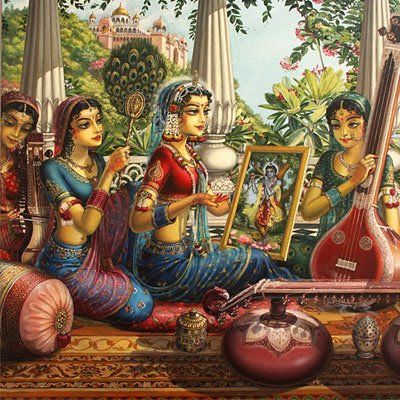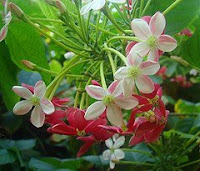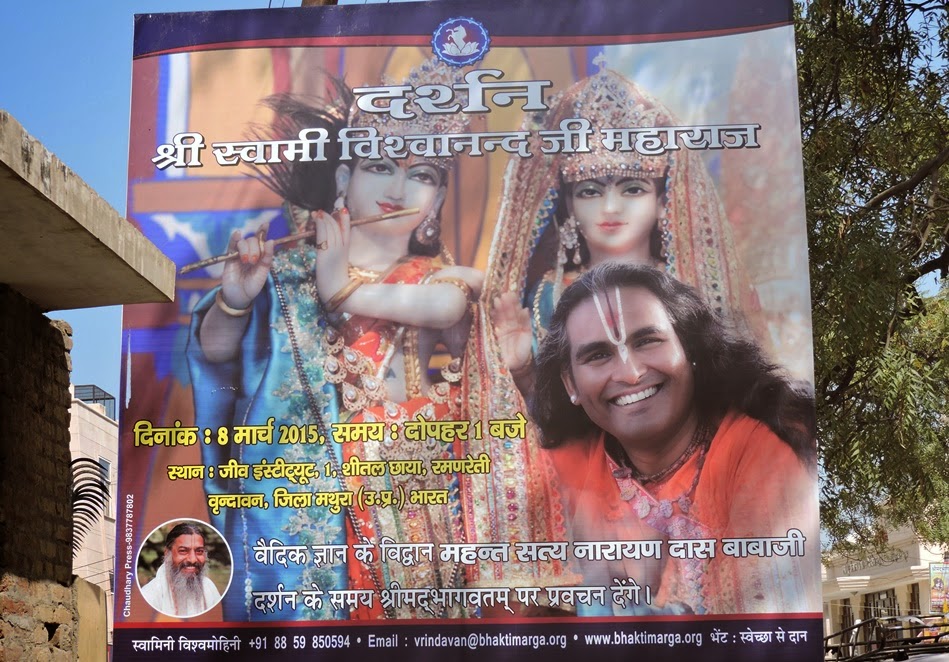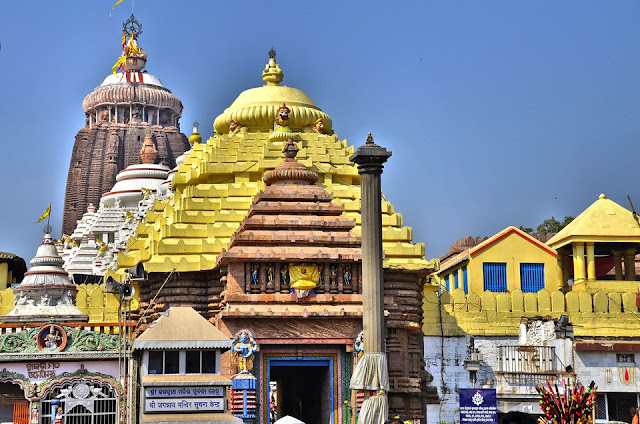Gopala-vijaya VI: Madana Puja

Let us continue our exploration of the Gopāla-vijaya. One of the novel details in the GPVJ version of the Krishna story is the gopis' worship of Kamadeva. This fits into the pūrva-rāga stage, i.e., prior to Radha and Krishna's first meeting.
Gopis worship other gods
The gopis are often pictured worshiping other gods. This is, first of all, the Katyayani Puja, which is a powerful addition to the Krishna cycle found in the Bhagavatam and derived originally from Alwar sources. But, in general, as I may already have mentioned, Devakinandan and the Gaudiyas separate the married gopis from the unmarried, and Radha is said to not have been present amongst the Katyayani-worshiping gopis. Nevertheless, there are some parallels between Katyayani Puja and Madana Puja, as we shall see below.
The Goswamis seem to consistently depict Radha and her sakhis as worshipers of Surya, while Chandravali and her sakhis worship a form of the Goddess Durga or Chandi. Radha's relationship to Suryadeva is given extra play in Lalita-mādhava, where Radha is saved and temporarily adopted by Surya Deva when she tries to commit suicide by jumping in the Yamuna. The Yamuna herself is a daughter of the Sun God. She is then given along with the Syamantaka jewel to Satrajit, another Surya bhakta, and becomes Satyabhama.
What exactly the significance of this relationship is for the Goswamis is something I haven't thought about much as yet. Krishnadas Kaviraj calls Radha padma-bandhu-rādhikā, "worshiper of the friend of the lotus flowers." Where this came from is also an unanswered question: Surya is one of the five gods worshiped by the Smartas, but independent worship or devotion to Surya is pretty much extinct. Vestiges like the Konark temple in Orissa are rare. So how and why this choice was made is a matter of conjecture. But then, Madana Puja is a pretty rare thing in present-day India also, though there is such a tradition. (See God of Desire: Tales of Kamadeva in Sanskrit Story Literature)
There is a Madana Puja described in the Ānanda-vṛndāvana-campū, but that seems different from the one that takes place here; in AVC, it is conducted between Vasanta Panchami and Maghi Purnima, a bit earlier than Vaishakh as described here.
As we saw recently, in CCN Kavi Karnapura depicts Radha and the gopis worshiping Gopishwar Mahadeva. This is also his occasion for the dāna-līlā to take place. In other accounts, the worshiping of a god is usually an opportunity for something else, some other type of pastime, usually Krishna disguising himself as a priest.
The dāna-līlā usually takes place either while the gopis are headed to Mathura to sell milk products in the bazaar (Śrī-kṛṣṇa-kīrtana and GPVJ, Rādhā-premāmṛta, and other original folk versions), or to a sacrifice at Govardhan (DKK and DKC). The rationale for this switch will have to be examined, but at first sight, I would assume that it is to show that the gopis' intention was to serve Krishna--even though they had been told to expect generous compensation for their ghee. This could in turn be seen as a case of motivated devotional acts having higher rewards, but that may be stretching beyond Rupa Goswami's intention.
The Gopis go with Barai to the Madana Mandap
In GPVJ, the gopis go to perform Madana Puja, which appears to be a regular function. They go accompanied by Barai, following her single file like ducklings floating in the river behind the mother duck.
As they walk, suddenly they come across Krishna who is watching them with great interest. Badai turns around, but it is too late and the gopis start thinking about displaying whatever flirtatious moves they have (30.44).
saba mane mane anumāne braja-bālā//
The time is spring, and Devakinandan says in what I think is a very nice pair of verses,
āre se rasika cuḍāmaṇi kānu pāśe
eta avasara bujhi catura kāmadeve
gopī bhāva upahāre govindāi seve
First of all, there are these young damsels, and secondly, it is the month of Vaishakh. Finally, there is Krishna, the chief of all rasikas. Clever Kamadeva, seeing this opportunity, rendered service to Krishna by making him a gift of the gopis' love. [Or, by giving the gopis love, served Krishna.] (30.46-47)Or, bhāva here probably means the anubhāvas, or external manifestations of inner moods rather than anurāga, as the description that follows is really all their foxy moves. So Kamadeva made a gift to Krishna of this vision of the gopis' reacting to his sight. Anubhāvas include things like vilāsa and moṭṭāyita, etc., which are especially produced when lovers meet by surprise in this way.
 Somehow, the wave that sweeps over the gopis and produces all these effects in them does not immobilize them completely and they manage to walk past Krishna. Following Barai who shows the way, they finally arrive at the Madana Mandap, the sacred altar of Kamadeva.
Somehow, the wave that sweeps over the gopis and produces all these effects in them does not immobilize them completely and they manage to walk past Krishna. Following Barai who shows the way, they finally arrive at the Madana Mandap, the sacred altar of Kamadeva.mādhavī latāra tale pātila āsane
rādha beḍhiyā basilā sakala sakhī-gaṇe
They spread their mats underneath a madhavi vine. Then Radha sat down and the sakhis also sat down, surrounding her. (30.68)
 Though all the gopis are troubled by feelings for Krishna, none dares say anything because of Barai's presence. Radha sees this and, says to Barai, "We have everything we need. We are only missing a Brahmin to do the puja. So please go quickly and bring one."
Though all the gopis are troubled by feelings for Krishna, none dares say anything because of Barai's presence. Radha sees this and, says to Barai, "We have everything we need. We are only missing a Brahmin to do the puja. So please go quickly and bring one."Barai leaves and the sakhis start to laugh, for now they can talk freely about Krishna. But who can describe Radha's state of mind? It was as though her entire body was bathing in kalakuta poison. One sakhi picks her up and holds her closely, but no matter what anyone says to her, she cannot respond. Her eyes are closed, but the tears wet her blouse. Kavisekhara concludes the chapter,
jā śunile ghare pāi nandera kumāra
Kavishekhara thus recounts Radha's abhisāra, the hearing of which results in getting Nanda's son in one's very own home. (30.86)I only mention this to show that the mood of bhakti is far greater in GPVJ than in SKK. I have a couple of other such colophon verses that I will tack on at the end of this post.
While looking for a Brahmani, Barai runs into Krishna
Chapter 31 begins with Krishna's pūrva-rāga.
se dige se dige rādhikā-maa dekhe tribhuvane
hṛdaa bethita kṛṣṇa kichu nāhi bāse
parāṇa na dhare eku rādhā abhilāse
In whatever direction he looked, the lotus-eyed Krishna saw the three worlds as nothing other than Radhika. His heart troubled, nothing in the world any longer brought him joy. He was barely able to sustain his life, so overpowered was he by desire for Radha. (31.6-7)Leaving aside his sakhās, Krishna followed the path taken by the gopis. But before he could reach the Madana altar, he encountered a gopi, Radha's sakhi Chandramukhi, who was resting in the shade of a kadamba tree.
They have a bit of an icy conversation at first, but when Krishna makes it known he is only interested in Radha, she opens up a little. But she is not encouraging, saying that he did not really have a chance. Do glass and gold belong together? Can you string pearls on a rope of hemp? Finally, she declines to intervene, except to tell Radha of his love for her. But if he really wants to get something done, he should ask Barai.
se je kore khaṇḍibāre nāre je vidhātā
Radha's grandmother is called Barai. Even God Himself cannot undo anything that she undertakes. (31.54)The conversation that follows with Barai is again mostly discouraging, some excerpts of which we have seen in the articles on Aiana and Barai, but finally she lets Krishna know that in fact Radha is eager to meet with him also.
Then Barai, taking Krishna with her, finds a young Brahman woman (brāhmaṇa-nārī, brāhmaṇa-kumārī) to act as priest and then returns to the Madana mandap. She tells Krishna to hide in the bushes and then heads for the gopis. When they see her coming, they have to clean up Radha who has been lying on the ground. They bring her to consciousness by telling her Barai is coming with Krishna, but of course it is just the Brahmin woman.
The chapter ends with the following puṣpikā, which sounds very classically Gaudiya. This could be the reason that some think Devakinandan is post-Gauranga, but I think verses like this probably predate Mahaprabhu.
aho niśi koho hari kathā
śunite parama sukha, kohite saphala mukha
ṭuṭae saṁsāra dukha bethā
Says Kavishekhara, "Listen, O foolish mankind! Speak of Hari day and night. Listening will make you joyful, it will perfect your speech and put an end to all the pains and sufferings of material life." (32.23)Madana Puja Itself
Chapter 33 is the description of the Madana puja. Surrounded by the gopis, Radha engages in the puja of Kamadeva. So beautiful is the scene, one would think that one was in the capital city of Madana himself (33.5). Radha makes the various offerings, but when she has to recite the meditation mantras of Kamadeva, she cannot help thinking of Krishna and this makes the flames of her love double in fury. When offering the dark-colored durva grass, it reminds her of Krishna's swarthy complexion. Whatever mantras the Brahmin woman makes Radha recite all turn into Krishna's name.
Radha's friends all laugh to see the puja turned upside down like this. Meanwhile Krishna is watching from behind a tamal tree, unnoticed, getting great relief and encouragement from what he sees. Seeing the beauty of the gopis, he feels he had a thousand eyes, like Indra.
Meanwhile the gopis conclude their worship by offering their prayer to Kamadeva. They stand in line, fold their hands and ask for the following blessing:
nandera nandana jena ho:iye nija pati
mane mane anuvara māge saba sahi
mo jena sobhāgī haṅ sabhākāre cāhi
"With devotion, I ask for this one blessing, that the son of Nanda should become my husband." All Radha's friends mentally asked for the secondary blessing that they should become Krishna's wives openly, with everyone's acceptance. (32.20-21)This is interesting that though these gopis did not participate (I think) in the Katyayani puja, the prayer is almost the same.
(Interestingly enough, I recently saw a Hindi film, Kitne dura kitne pas, in which there is a scene in which the kātyāyani mahāmāye verse was chanted during a ritual that was kind of a marriage. The couple was not married nor yet really in love, but forced to travel together with the result that people thought they were. Anyway, I may comment further on this film later, comparing it to an American romantic comedy.)
Here the married gopis are asking for something impossible, to be married to Krishna when they are already wed. In other words, it cannot be said that they are asking for a parakiya relationship. But since the worship is of Madana, it would seem that erotic love is being given precedence over marriage itself. Anyway, it is not clear to me exactly what the significance is at this point, except that it enters into the wider category of Kama = Krishna, and the whole erotic aspect of Krishna worship in general.
kāma-gāyatri kāma-bīje jāṅra upāsana
puruṣa-yoṣit kiṁ vā sthāvara-jaṅgama
sarva-cittākarṣaka sākṣāt manmatha-mathana
In Vrindavan there is a transcendental, ever fresh Cupid who is worshiped by the Kama Gayatri and Kama bija mantras. He attracts the consciousness of all creatures, whether male or female, still or moving; he is the churner of even Cupid’s mind. (CC 2.8.137-138)We will have to explore this verse and the corresponding one in 2.21 more fully later.
As the gopis prayed to be Krishna's wives, he looked on and smiled. Suddenly Radha's eyes fell on him, but she thought that Kamadeva was appearing before her. She was dumbfounded, but Krishna took the opportunity to disappear.
Barai Convinces Radha
With the puja completed, the gopis went and took the dust of Barai's feet. And she also gave them her blessings. She then took rest, putting her head on Radha's lap. With the exception of one or two sakhis, all the other gopis went home, worried about their mothers-in-law. When Barai woke up, Radha signaled to her friends to go pick flowers or something, i.e., to leave them alone. This is where Barai praises Radha and tells her that her husband is unworthy of her ("buffoon cowherd").
ravira udae jena nalinī vikaśe
to heno sundarī jabe kānu hae pati
tabesi milae jena lakṣmī lakṣmīpati
One's pleasure in love (rasa) increases when one unites with a suitable lover, like a lotus flower blooms with the rising of the sun. When a beautiful woman like you takes Krishna as her husband, then it seems that Lakshmi has been united with Narayana. (33.40-41)Ah, but love does not flow smoothly... And how pure women are!! Radha refuse categorily to be convinced by Barai.
ihāte kalaṅka dite cāho kona mane
Both my parental family and my husband's family are as bright as the sun. What makes you want to ruin their reputation? (33.58)[And of course, these considerations have not died: In the Hindi film mentioned above, the heroine also tells her father that she will not marry the man she loves, but the man who has been arranged for her, all for the sake of the family and her father's reputation. "What will people say, he is the head of the city council, but he can't even control his daughter. What shame will befall you!"]
I am going to make a long story short here. As in the Śrī-kṛṣṇa-kīrtana, Barai goes back and forth a couple of times. But whereas in SKK, Krishna sent a gift of tambul that Radha crushed underfoot, insulting Barai and leading to her desire to undermine Radha by destroying her virtue (or something like that), Krishna gives a gajamati hāra, a pearl necklace. Radha refuses it at first, throwing it on the ground (as in SKK), but Barai picks it up and places it around her neck. And Radha finally acknowledges that she will do whatever Barai asks.
e tirira dukha sukha saba tora bhāra
e bola śuniyā būḍhi pāila baḍa sukha
lākha lākha cumba dila rādhikāra mukha
O Barai, I agree to your request. This woman's happiness and distress are all in your hands now. Hearing these words, the old lady was very happy and placed thousands of kisses on Radha's face. (34.100)
Gopāla-vijaya Articles
Gopāla-vijaya II: Beginning of Madhura-rasa section
Krishna's Purva-rāga and Divine Helplessness
Gopāla-vijaya V: Aihana the Cuckold




Comments
I have 2 questions about Dana Keli Kaumedi:
1) What exactly does it mean? "Dana" = give in charity; does "Kaumudi" really mean comedy like in English language?
And if so, is it because Sanskrit is mother tongue of the Romance languages? Or is it just coincidence that "comedy" and "Kaumudi" look alike and pronounced similarly?
2) Second question: is it true that one saintly person was sad and this DKK was written to cheer up the person?
Thanks...pranams
The story of DKK being written for Raghunath Das Goswami is widely known. Many people have written it. To make a long story short, Raghunath was distressed by the descriptions of separation in Lalita-madhava, so Rupa Goswami wrote DKK, a pastime of union, to cheer him up. And this lila kept him in good cheer for the rest of his bhajan life. One of the very last verses in DKK mentions Raghunath Das and dedicates the play to him.